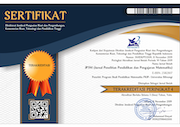Learning trajectory dan obstacle mahasiswa dalam mengabstraksi berdasarkan konstruk Teori Valsiner
Abstract
The learning process was generally conventional in nature regardless of the obstacle experienced by students, it is important to figure out the trajectory do obstacle students, so expect students as prospective teachers can develop its mathematical abstraction ability. This paper discusses about the Trajectory (Path), the Obstacle (any difficulty) in abstraction, designed based on the learning theory of constructivist approach valsiner. The purpose of this research is to examine the obstacle of students through the search trajectory. The method of this study refers to the development model of Tjeerd Plomp with qualitative approaches. The subject is students who follow courses semester V opportunity Theory in University Mathematics Education courses Siliwangi. Search results: learning trajectory through the obstacle findings obtained a student’s difficulty in understanding the concept of the material making it harder in resolving the question of the story related to everyday life–day. The second obstacle, namely the inability of students in represents the answer to question into a word–the word, sentence or notation. The third obstacle, the student still difficulty in connect between one concept with another concept. The fourth obstacle is experiencing confusion due to not knowing the techniques and characteristics of the finish reserved. There are three fundamental questions in this paper, namely what, why and how to develop the trajectory and know the obstacle of students in the process of abstraction based on the theory of Valsiner?
Keywords: Trajectory, Obstacle, Abstraction, Valsiner Theory.
Full Text:
view PDFReferences
Clements, et.al. (2009). Learning and Teaching Early Math The Learning Trajectories Approach. New York: Routledge.
Orton. (1987). Learning Mathematics. London:Casel Educational Limited.
Patahuddin, et.all. (2010). Model pengembangan profesi guru secara otentik. orasi ilmiah penguatan karakter bangsamelalui revitalisasi pendidikan gurudengan model pengembangan profesi guru otentikuniversitas negeri surabaya, Jurnal Penelitian Inovasi dan Perekayasa Pendidikan, http://www.academia.edu.
Plomp, T. (1997). Educational Design: Introduction. From Tjeerd Plomp (Eds). Educational & Training System Design: Introduction. Design of Education and Training (in Dutch). Utrecht (the Netherlands): Lemma. Netherland. Faculty of Educational Science and Technology, University of Twente
Shokouhi, M. ,et.all. (2015). Revisiting Vygotsky’s Concept of Zone of Proximal Development: Towards a Stage of Proximity. Academic Research Journals. International Journal of English Literatur and Culture. Vol 3(2). Pp. 60 – 63. 7 February 2015.
Suryadi. (2013). Didactical Design Research (DDR) to Improve The Teaching of Mathematics. Far East Journal of Mathematical Education, 10(1), 91-107.
Sumardyono. (2004). Karakteristik Matematika dan Implikasinya terhadap Pembelajaran Matematika. Departemen Pendidikan Nasional. Direktorat Jendral Pendidikan Dasar dan Menengah. Pusat Pengembangan Penataran Guru Matematika. Yogyakarta.
Tata. (2015). Peningkatan Kemampuan Permodelan dan Abstraksi Matematis serta Motivasi Belajar Siswa Sekolah Menengah Pertama melalui Pembelajaran Kontekstual Kolaboratif. Disertasi, Sekolah Pascasarjana, Universitas Pendidikan Indonesia, Bandung.
Tall,D. (1991). Advanced mathematical thinking. Mathematics Education Library. Dordrecht: Kluwer Academic Publishers Group
Trianto. (2011). Mendesain Model Pembelajaran Inovatif – Progresif. Edisi pertama cetakan ke empat. Jakarta. Kencana Predana Media Group.
Triyanto. (2011). Modifikasi Pembelajaran Statistika Matematika dengan Metode Peta Konsep Melalui Pendekatan Analogi. Artikel Penelitian. Program Studi Pend. Matematika FKIP UNS. JMEE Volume 1 Nomor 2, Desember 2011.
Yuhasriati. (2012). Pendekatan Realistik dalam Pembelajaran Matematika. Jurnal Peluang , Volume 1, Nomor 1, Oktober 2012, ISSN: 2302-5158.
DOI: https://doi.org/10.37058/jp3m.v3i2.365
Refbacks
- There are currently no refbacks.
©2017 JP3M (Jurnal Penelitian Pendidikan dan Pengajaran Matematika)
Program Studi Pendidikan Matematika
Fakultas Keguruan dan Ilmu PendidikanÂ
Universitas Siliwangi
Jl. Siliwangi No. 24 Kota Tasikmalaya - 46115
email: jp3m@unsil.ac.id
e-ISSN: 2581-2807 ; p-ISSN: 2460-8599

This work is licensed under a Creative Commons Attribution-NonCommercial-ShareAlike 4.0 International License.
StatCounter:
Detail


